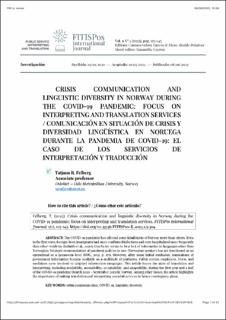| dc.contributor.author | Felberg Radanovic, Tatjana | |
| dc.date.accessioned | 2023-03-03T08:07:51Z | |
| dc.date.available | 2023-03-03T08:07:51Z | |
| dc.date.created | 2022-06-09T16:03:59Z | |
| dc.date.issued | 2022-06-08 | |
| dc.identifier.citation | FITISPos-International Journal (FITISPos-IJ). 2022, 9 (1), 125-145. | en_US |
| dc.identifier.issn | 2341-3778 | |
| dc.identifier.uri | https://hdl.handle.net/11250/3055597 | |
| dc.description.abstract | The COVID-19 pandemic has affected some inhabitants of Norway more than others. Even in the first wave, foreign-born immigrants had more confirmed infections and were hospitalized more frequently than other residents (Indseth et al., 2020). One factor seems to be a lack of information in languages other than Norwegian. Strategic communication of pandemic policies to non-Norwegian speakers has not functioned on an operational or a grassroots level (NOU, 2021, p. 175). However, after some initial confusion, translations of government information become available on a multitude of platforms. Public service employees, NGOs, and mediators were involved in targeted information campaigns. This article traces the state of translation and interpreting, including availability, accessibility, acceptability, and adaptability, during the first year and a half of the COVID-19 pandemic (March 2020 – September 2021) in Norway. Among other issues, the article highlights the importance of making translation and interpreting essential services in future contingency plans.
La pandemia de COVID-19 ha afectado a los habitantes de Noruega de manera desigual. Durante la primera ola ya se había constatado que los inmigrantes nacidos en el extranjero representaban cifras más altas de contagios e ingresos en hospital que otros residentes (Indseth et al., 2020). La falta de información en otras lenguas, además del noruego, parece haber sido uno de los factores que impulsaron esta disparidad. La comunicación estratégica de medidas relacionadas con la pandemia relativas a los que no hablan noruego no ha funcionado de forma operativa ni estructural (NOU, 2021, p. 175). No obstante, tras la confusión inicial, la información transmitida por el gobierno empezó a traducirse y a difundirse en multitud de plataformas. Funcionarios de los servicios públicos, ONGs y mediadores participaron en campañas de información dirigidas a grupos lingüísticos concretos. En este artículo se analiza la situación de la traducción y la interpretación durante el primer año y medio de la pandemia de COVID-19 (marzo de 2020 a septiembre de 2021) en Noruega, en particular, en lo relativo a la disponibilidad, accesibilidad, aceptabilidad y adaptabilidad. Entre otras cuestiones, el artículo destaca la importancia de integrar a la traducción y la interpretación como servicios indispensables en futuros planes de contingencia. | en_US |
| dc.language.iso | eng | en_US |
| dc.publisher | Universidad de Alcalá | en_US |
| dc.relation.ispartofseries | FITISPos-International Journal (FITISPos-IJ);Vol. 9 No. 1 (2022): The impact of the COVID-19 pandemic on Public Service Interpreting and Translation (PSIT) and its future developments | |
| dc.rights | Navngivelse-Ikkekommersiell 4.0 Internasjonal | * |
| dc.rights.uri | http://creativecommons.org/licenses/by-nc/4.0/deed.no | * |
| dc.title | Crisis communication and linguistic diversity in Norway during the COVID-19 pandemic: Focus on interpreting and translation services | en_US |
| dc.title.alternative | Comunicación en situación de crisis y diversidad lingüística en Noruega durante la pandemia de COVID-19: el caso de los servicios de interpretación y traducción | en_US |
| dc.type | Peer reviewed | en_US |
| dc.type | Journal article | en_US |
| dc.description.version | publishedVersion | en_US |
| cristin.ispublished | true | |
| cristin.fulltext | original | |
| cristin.qualitycode | 1 | |
| dc.identifier.doi | https://doi.org/10.37536/FITISPos-IJ.2023.1.9.304 | |
| dc.identifier.cristin | 2030560 | |
| dc.source.journal | FITISPos-International Journal (FITISPos-IJ) | en_US |
| dc.source.volume | 9 | en_US |
| dc.source.issue | 1 | en_US |
| dc.source.pagenumber | 125-145 | en_US |

